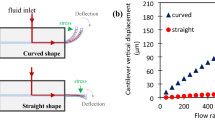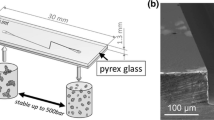Abstract
The microfluidic flowing on chip surface depends on the external load such as centrifugal force, magnetic force and bubbles, but it leads to the complexity of microsystem. Hence, a self-flowing is proposed inside microchannel on chip surface without any external load. The objective is to explore how micro-/nanoscale surface topographies of microchannel influence the microfluidic flowing. First, the microgrinding with a diamond wheel microtip was employed to fabricate the accurate and smooth V-shaped microchannel with the height of 300 µm and less; then, the microfluidic flowing state was modeled by the flowing concave with the parameterization of flow-end height; finally, the microfluidic flowing speed was experimentally investigated with reference to microchannel angle, gradient, surface roughness and chip material. It is shown that the microfluidic self-flowing is mainly induced by the microchannel tip and the nanometer-scale surface cracks around the microchannel tip. Small microchannel angle, large microchannel gradient and smooth microchannel surface may enhance the flowing speed on chip surface. The brittle quartz glass produces the nanometer-scale surface cracks around the microchannel tip, leading to an increase about 40 times in the self-flowing speed compared with the ductile polymer. It is confirmed that the self-flowing speed in dynamic state may be characterized by the proposed concave flow-end height.














Similar content being viewed by others
References
Arscott S (2014) SU-8 as a material for lab-on-a-chip-based mass spectrometry. Lab Chip 14:3668–3689
Berthiera E, Beebe DJ (2007) Flow rate analysis of a surface tension driven passive micropump. Lab Chip 7:1475–1478
Chao CY, Wang CH, Che YJ, Kao CY, Wu JJ, Lee GB (2016) An integrated micro fluidic system for diagnosis of the resistance of Helicobacter pylori to quinolone-based antibiotics. Biosens Bioelectron 78:281–289
Chen PC, Pan CW, Lee WC, Li KM (2014) An experimental study of micromilling parameters to manufacture microchannels on a PMMA substrate. J. Adv Manuf Technol 71:1623–1630
Farshchian B, Gatabi JR, Bernick SM, Park S, Lee GH, Droopad R, Kim N (2017) Laser-induced superhydrophobic grid patterns on PDMS for droplet arrays formation. Appl Surf Sci 396:359–365
Garza-García LD, García-López E, Camacho-León S, Del RRM, López-Pacheco F, López-Meza J, Araiz-Hernández D, Tapia-Mejía EJ, Santiago GT, Rodríguez -González CA, Alvarez MM (2014) Continuous flow micro-bioreactors for the production of biopharmaceuticals: the effect of geometry, surface texture, and flowrate. Lab Chip 14:1320–1329
Hosokawa K, Fujii T, Endo I (1999) Handling of picoliter liquid samples in a poly (dimethylsiloxane)-based microfluidic device. Anal Chem 71:4781–4785
Hu YD, Werner C, Li D (2003) Influence of three-dimensional roughness on pressure-driven flow through microchannels. J Fluids Eng 125:871–879
Li JM, Liu C, Qiao HC, Zhu LY, Chen G, Dai XD (2008) Hot embossing/bonding of a poly(ethylene terephthalate) (PET) microfluidic chip. J Micromech Microeng 18:015008
Liu MC, Wu JG, Tsai MF, Yu WS, Lin PC, Chiu IC, Chin HA, Cheng IC, Tungc YC, Chen JZ (2012) Two dimensional thermoelectric platforms for thermocapillary droplet actuation. RSC Adv 2:1639–1642
Matin MH, Khan WA (2016) Electrokinetic effects on pressure driven flow of viscoelastic fluids in nanofluidic microchannels with Navier slip condition. J Mol Liq 215:472–480
Mavrogiannis N, Desmond M, Gagnon ZR (2015) Fluidic dielectrophoresis: the polarization and displacement of electrical liquid interfaces. Electrophoresis 36:1386–1395
Melchels FP, Feijen J, Grijpma DW (2010) A review on stereolithography and its applications in biomedical engineering. Biomaterials 31:6121–6130
Ni Q, Capecci DE, Crane NB (2015) Electrowetting force and velocity dependence on fluid surface energy. Microfluid Nanofluid 19:181–189
Oh KW, Lee K, Ahna B, Furlani EP (2012) Design of pressure-driven microfluidic networks using electric circuit analogy. Lab Chip 12:515–518
Prakash M, Gershenfeld N (2007) Microfluidic bubble logic. J Sci 315:832–836
Squires TM, Quake SR (2005) Microfluidics: fluid physics at the nanoliter scale. Rev Mod Phys 77:977–1026
Xie J, Wu KK, Cheng J, Li P, Zheng JH (2015) The micro-optic photovoltaic behavior of solar cell along with microlens curve surfaced glass substrate. Energy Convers Manag 96:315–321
Yang C, Yin XH, Cheng GM (2013) Microinjection molding of microsystem components: new aspects in improving performance. J Micromech Microeng 23:093001
Yuan C, Huang MY, Yu XJ, Ma YP, Luo XB (2016) A simple approach to fabricate the rose petal-like hierarchical surfaces for droplet transportation. Appl Surf Sci 385:562–568
Acknowledgement
The project was supported by the Natural Science Foundation of Guangdong Province (Grant No. 2015A030311015), the National Natural Science Foundation of China (Grant No. 61475046), the Guangzhou Science and Technology Program key Project (Grant No. 201508030012) and the Guangdong Science and Technology Department (Grant No. 2014B010104003).
Author information
Authors and Affiliations
Corresponding author
Electronic supplementary material
Rights and permissions
About this article
Cite this article
Xie, J., Su, H., Liao, J. et al. Experimental study on self-flowing speed in microchannel related to micro-/nanoscale surface topographies. Microfluid Nanofluid 21, 106 (2017). https://doi.org/10.1007/s10404-017-1940-5
Received:
Accepted:
Published:
DOI: https://doi.org/10.1007/s10404-017-1940-5





